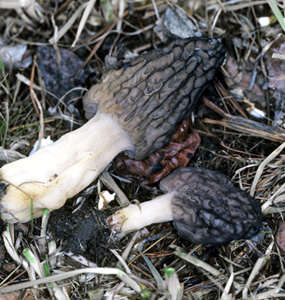Morchella elata

Image Courtesy of Dan Guravich
| Click to Enlarge |
| Click For Image Gallery |
|
Group of Fungi: Morels Family: Morchellaceae Latin Name: Morchella elata Fr. Common Name: Black Morel Description: Total height 3–6 in (7.5–15 cm), consisting of a honeycomb-like or sponge-like cap held aloft on a cylindrical stalk, cap 3/4–1 1/4 (2–3 cm) wide and 2–4 in (5–10 cm) long, conical to more often elongated, dark brown to black with the pits in the cap yellow-brown, pits elongated and longitudinally arranged; stalk 1 5/8–3 in (2.5–7.5 cm) long, 5/8–1 in (1.5–2.5 cm) in diameter, smooth to slightly furrowed, hollow, white to pale yellow; spores cream to light buff in mass. Biological Role: Often listed as decomposers of litter and humus, but there is some evidence that morels can form mycorrhizal associations with forest trees. Habitat: On the ground in broadleaf or conifer forests; solitary or occurring in small or large groups. Geographical Distribution: Found throughout North America but apparently more common in the east. Comments: Morchella elata is the name most often applied to the commonly encountered black morel, but a complex consisting of several species is certainly involved. Black morels are often the first morels to appear in the spring. Like the yellow and half-free morel, it is considered to be edible when cooked. No morel should ever be consumed raw. |
| Go Back |